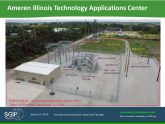Veridian Connections announced this week they are rolling out a “virtual power plant,” with a new microgrid system. The southern Ontario utility says the microgrid project will provide significant benefits to their customers.
“This project serves as the ideal opportunity for Veridian to further highlight and enhance the integration of renewables with microgrid operation into Ontario’s energy landscape for our customers. It’s also the first step in developing a system that will allow all types of microgrids to be added to an integrated system that will provide benefits for Veridian and improve the quality of life for our customers,” said Veridian President and CEO Michael Angemeer.
Veridian’s new microgrid will feature Tesla’s Powerwall battery, mixed with electric vehicle charging, and solar electricity. The system will be up by Q2 this year, and deployed as two connected residential microgrid systems. The project is an early example of TESLA’s microgrid strategy that includes the purchase of SolarCity.
These parts will consist of 10kW of solar electricity, 14 kWh lithium-ion battery storage with a hybrid inverter, along with level 2 & 3 electric vehicle charging, and Veridian’s SCADA system. Additional components also include: an information display at Veridian’s Ajax headquarters, along with a Tesla 7kWh Powerwall with microgrid controls, plus a solar energy system in Pickering, Ontario.
Veridian will provide a 24/7 grid operations system, while Opus One Solutions, a software solutions and engineering company, has been chosen to create and set up the “virtual power plant,” with its GridOS microgrid energy management system. According to Opus One, GridOS is an “energy modeler and resource optimizer that realizes the promises that microgrids bring.”
Opus One is also working with National Research Council of Canada Industrial Research Assistance Program (NRC-IRAP) to develop a National Microgrid Network in Canada.
“We are excited to partner with Opus One, and look forward to demonstrating the true operation of the microgrid by managing various energy resources – from minimizing the cost of electricity under time-of-use rates, generating credits through the net metering program and responding to utility signals under demand response programs or an optimized combination of them all,” Angemeer said.
Opus One President and CEO Joshua Wong said they are excited about teaming up with Veridian in its microgrid venture.
“Opus One is thrilled to have been selected to partner with Veridian Connections, an innovative utility focused on deploying new technologies and service models that provide increased value to their customers. We look forward to supporting Veridian towards a common vision of the Energy Internet of the future,” he said.
Veridian’s microgrid is adding flexibility by allowing more renewables to come on line- providing customers more choice. Perhaps more importantly, Veridian is providing more resiliency to its grid; a key feature for 21st century electrical systems. Greater risks of extreme weather events from climate change can increase power vulnerability, as seen with Hurricane Sandy in 2012, and flash flooding in Greater Toronto in 2013. Several utilities in addition to Veridian are starting to see microgrids as a solution for reducing power outages in extreme weather events. ComEd is planning on building a microgrid system in Rockford, Illinois to cut extreme weather risks, and provide necessary electricity in emergencies.
These are the opportunities which microgrids provide, and Veridian is seeks to demonstrate with their “virtual power plant.”





